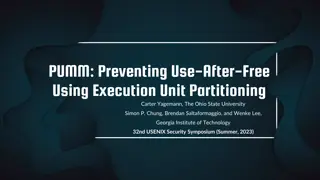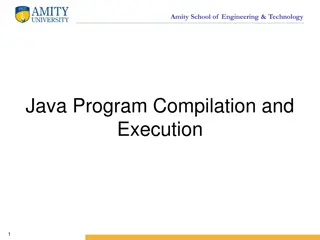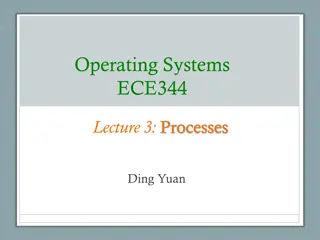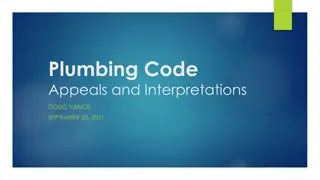Budget Execution Challenges in Somalia's Social Sectors
Addressing malnutrition in Somalia is hindered by low budget execution rates in the health and education sectors. Only a small portion of Official Development Assistance (ODA) is channeled through government systems, impacting service delivery and development financing. Donor-supported budgets for h
0 views • 32 slides
PUMM: Preventing Use-After-Free Using Execution Unit Partitioning
Memory-unsafe languages like C and C++ are prone to Use-After-Free (UAF) vulnerabilities. PUMM introduces execution unit partitioning to efficiently tackle this issue. By segregating and managing execution units, PUMM aims to prevent UAF exploits and enhance software security.
0 views • 31 slides
Symbolic Execution Tree for a Program
Generate the complete symbolic execution tree for a given program by annotating nodes with path constraints and line numbers, aiding in understanding program execution flow.
0 views • 26 slides
The Impact of No Code-Low Code on Startup Innovation
In the vibrant world of startups, innovation is the cornerstone of success. As these businesses aim to carve out their niches, they often face a common hurdle: the extensive resources required for traditional software development. However, the emergence of low code no code (LCNC) platforms is revolu
2 views • 12 slides
Amity School of Engineering & Technology - Java Program Compilation and Execution
Explore the steps for compiling and running a Java program at Amity School of Engineering & Technology. Learn about the compilation and execution process, converting source code into byte code, creating directories, renaming files, and launching command prompts. Dive into the world of Java programmi
1 views • 19 slides
Improving Code Analysis Workflow with Jenkins, Sonar, and Gerrit
Enhance code analysis processes by analyzing source code before merging, enabling analysis in branches, and triggering Jenkins jobs. Sonar.cloud provides options to analyze branches using Maven build, while the proposal suggests using Jenkins plugin for code review. Addressing challenges with Gerrit
1 views • 12 slides
Understanding the Neglected Provisions of Order XXI CPC, 1908
Explore the overlooked aspects of Order XXI CPC, 1908, focusing on the definitions, types of decrees, modes of execution, procedures for executing decrees, reasons for neglect, impact, recommendations, and conclusion. Learn about neglected provisions like summary execution, execution against legal r
0 views • 14 slides
Understanding Software Testing: Test Cases, Selection, and Execution
Software testing plays a crucial role in identifying and resolving issues within software products. Test cases, selection, and execution are fundamental aspects of the testing process. Test cases define conditions for testing software functionality, with a focus on repeatability and data specificity
2 views • 36 slides
Understanding Binary Coded Decimal (BCD) and Excess-3 Code
Binary Coded Decimal (BCD) is a binary code used to represent decimal numbers, with the popular 8421 BCD code and its conversion process explained. Additionally, Excess-3 Code, another BCD code, is detailed with an example of finding its code for a given decimal number. Different BCD codes like 4221
0 views • 11 slides
A New Complaint Handling Code for the Sector - Webinar Highlights
This webinar discusses the introduction of a new Complaint Handling Code for the sector, aiming to address issues in social housing complaint processes. It covers key points, the background leading to the code's development, the Ombudsman's experience, and the code's aims and framework towards high-
0 views • 14 slides
The Board of Taxation Voluntary Tax Transparency Code Overview
The Board of Taxation developed a voluntary Tax Transparency Code to address community concerns and promote greater tax transparency among large businesses. The Code outlines recommended disclosures for both large and medium businesses, encouraging adoption of higher disclosure standards. Internatio
0 views • 20 slides
Simplifying AI Development with Low-Code and No-Code Platforms
Explore the world of low-code and no-code AI development platforms, empowering experts to create applications with ease. Learn about the benefits, tools, and components of these innovative platforms, and discover popular AI tools for no-code development. Accelerate your digital transformation journe
0 views • 11 slides
Understanding Pseudo Code and Flow Charts for Algorithm Analysis
Explore the concepts of pseudo code and flow charts for analyzing algorithms, problem-solving, and understanding space and time complexity. Learn about basic elements of pseudo code, assigning operations, and writing effective pseudo code statements in a clear and structured manner. Discover the imp
0 views • 26 slides
Enhancing Code Status Discussions in End-of-Life Care: A Quality Improvement Project
This project led by Dr. John Rutkowski aims to reduce inappropriate interventions for patients with DNR or Modified Code Status by implementing an improved code status documentation system. Data analysis reveals a need for better documentation practices, and survey responses highlight various challe
0 views • 18 slides
Understanding Conditional Execution in Programming
Conditional execution, such as the if statement, allows executing specific blocks of code based on certain conditions being met. This concept is fundamental in programming and is demonstrated through examples like if, if/else, relational expressions, and nested if/else constructs. The incorrect usag
2 views • 44 slides
Ensuring Security in Persistent Key-Value Stores using Shielded Execution
This content discusses the challenges and solutions for securing LSM-based Key-Value stores in untrusted computing environments using Shielded Execution. It addresses the need for confidentiality, integrity, and freshness of data in persistent storage systems. The research explores Trusted Execution
0 views • 32 slides
Modes of Execution of Decree in Civil Law
The lecture discusses the various modes of execution of decree in civil law, such as execution against a person through arrest and detention, and execution against property. It explains the procedures involved in arrest and detention, including the conditions for release, restrictions on arrest, and
0 views • 9 slides
Understanding Java Memory Management
Explore how memory is managed in Java programs, including memory allocation for code, objects, and execution stack. Learn about memory areas like the execution stack and heap, and understand the concept of activation records in method execution.
0 views • 27 slides
Exploring Instruction Level Parallel Architectures in Embedded Computer Architecture
Delve into the intricacies of Instruction Level Parallel Architectures, including topics such as Out-Of-Order execution, Hardware speculation, Branch prediction, and more. Understand the concept of Speculation in Hardware-based execution and the role of Reorder Buffer in managing instruction results
0 views • 51 slides
Evolution of Execution Methods in Modern Society
Explore the historical and modern methods of execution, from hanging to lethal injection, and the transition towards more civilized approaches. Learn about the contributions of prominent figures like Elbridge Gerry in advocating for humane execution methods. Delve into the commercial rivalry between
0 views • 13 slides
Secure and Efficient Multi-Variant Execution in Distributed Settings
This paper discusses dMVX, a system for secure multi-variant execution in distributed settings to mitigate memory errors and protect against attacks. Using leader and follower variants, diversified program variants run in lockstep to ensure security. The system monitors and replicates I/O results, e
0 views • 35 slides
Understanding the .NET Architecture Components
The .NET architecture comprises various key components such as the Common Language Specification, Code Manager, Managed Code, Unmanaged Code, and Native Code. These components play crucial roles in the development and execution of applications within the .NET framework. Managed code is executed by t
0 views • 21 slides
Challenges in Code Search: Understanding, Matching, and Retrieval
Programming can be challenging due to the lack of experience and unfamiliar libraries. Code search engines struggle with representing complex tasks, while information retrieval techniques aim to bridge the gap between source code and natural language queries. The mismatch between high-level intent a
0 views • 21 slides
Hardware-Assisted Task Scheduler for OS Intensive Applications
A hardware-assisted task scheduler called SchedTask is proposed to address the issue of instruction cache pollution in OS intensive applications. By utilizing SuperFunction characterization and a specialized scheduler, the system aims to optimize task execution on different cores for improved perfor
0 views • 28 slides
Understanding Code Execution Graphs and Superblocks in Software Analysis
Explore the concepts of Static Execution Graphs, Dynamic Execution Graphs, Superblocks, hot-path detection, and memory arithmetic in software analysis. Learn about the grouping of blocks, violation tracking, control dependencies, and code behaviors across time through these graphical representations
0 views • 9 slides
Multi-Label Code Smell Detection with Hybrid Model based on Deep Learning
Code smells indicate code quality problems and the need for refactoring. This paper introduces a hybrid model for multi-label code smell detection using deep learning, achieving better results on Java projects from Github. The model extracts multi-level code representation and applies deep learning
0 views • 10 slides
Understanding Processes in Operating Systems - ECE344 Lecture 3 Summary
This lecture delves into the essential concepts of processes, threads, and synchronization in operating systems. Key topics covered include units of execution, representation of units of execution in the OS, process execution states, and state transitions. Users, programs, and the role of processes
0 views • 45 slides
InvisiSpec: Making Speculative Execution Invisible
InvisiSpec presents a novel defense mechanism to address speculative execution attacks in the cache hierarchy. By making speculative execution invisible to potential attackers, this holistic approach aims to mitigate the risks associated with exploiting side effects on incorrect paths, such as Spect
0 views • 18 slides
Multicycle Datapath and Execution Steps Overview
This content provides a detailed explanation of a multicycle datapath and the execution steps involved in processing instructions. It covers key elements such as instruction fetching, decoding, memory referencing, ALU operations, branch and jump instructions, as well as memory access for read and wr
0 views • 11 slides
Understanding Symbolic Execution and Directed Automated Random Testing
Symbolic Execution is a method used for analyzing programs to determine inputs causing each part to execute, vital in program testing. However, limitations arise in cases without code availability, hindering definitive path conditions. Directed Automated Random Testing (DART) overcomes this through
0 views • 20 slides
Secure Cloud Applications with Intel SGX - OSDI 2014 Presentation Summary
This presentation discusses the challenges of trusting cloud environments and proposes solutions utilizing Intel SGX technology. It explores the need for secure execution of applications on untrusted cloud platforms, presents existing solutions, and introduces the concept of Haven for private execut
0 views • 33 slides
Rethinking Processes with Threads in Operating Systems
Processes in operating systems traditionally include various resources and execution states, leading to inefficiencies in communication and parallel program execution. By separating the concept of a process from its execution state, modern OSes like Mac, Windows, and Unix introduce threads as lightw
0 views • 29 slides
Lazy Code Motion and Partial Redundancy Elimination in Optimizing Compiler
Lazy code motion, partial redundancy elimination, common subexpression elimination, and loop invariant code motion are optimization techniques used in compilers to improve code efficiency by eliminating redundant computations and moving code blocks to optimize performance. These techniques aim to de
0 views • 35 slides
Python Programming Essentials: Basics, Operators, Expressions, and Control Flow
This segment delves into the fundamentals of Python programming with a focus on essential concepts such as comments, numbers, strings, variables, arithmetic operators, logical operators, order of execution, expressions, and control flow statements like conditional execution and looping. Learn about
0 views • 12 slides
Loop Invariant Code Motion in Frequent Paths for Optimization
Loop Invariant Code Motion (LICM) is a key optimization technique that identifies and moves code operations whose operands remain constant within a loop to improve performance. The process involves careful consideration of memory operations and operations not executed every iteration. The assignment
0 views • 20 slides
Understanding Operating System Concepts: Multiprogramming, Multiprocessing, Multitasking, and Multithreading
In the realm of operating systems, terms like multiprogramming, multiprocessing, multitasking, and multithreading can often be confusing due to their similar appearance but distinct meanings. These concepts play a crucial role in efficiently managing resources in a computing system, particularly in
0 views • 6 slides
Memory Allocation and Program Execution Overview
Understanding memory allocation is crucial for efficient program execution. This content delves into the importance of memory allocation, considerations for storing data during program execution, and the requirements for allocating memory efficiently. It also explores solutions for managing memory s
0 views • 35 slides
Plumbing Code Appeals and Interpretations Overview
This document provides information on the agenda, upcoming professional development events, Building Code Appeal Board, Appeal Board decisions, Code Interpretation Committee, code interpretations, and final thoughts related to plumbing code appeals and interpretations. It covers the appeal process,
0 views • 8 slides
Understanding CPU Virtualization and Execution Control in Operating Systems
Explore the concepts of CPU virtualization, direct execution, and control mechanisms in operating systems illustrated through a series of descriptive images. Learn about efficient CPU virtualization techniques, managing restricted operations, system calls, and a limited direct execution protocol for
0 views • 18 slides
Guide to Measuring C++ Code Execution Time
Learn how to accurately measure the execution time of your C++ code for performance tuning, bottleneck identification, and real-time system requirements. Understand different types of time measurements, utilize the STL chrono library, and follow a step-by-step process to time your code effectively w
0 views • 13 slides







































